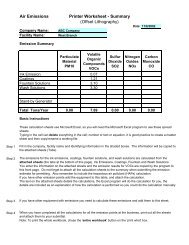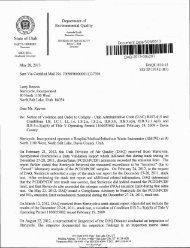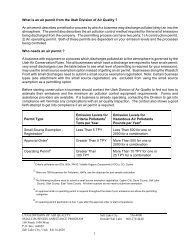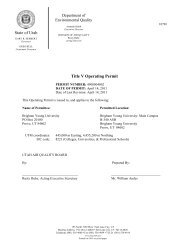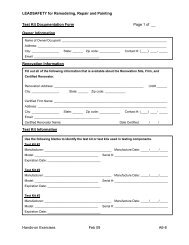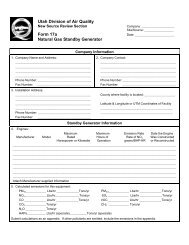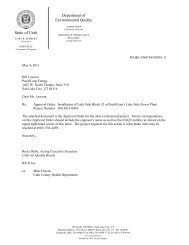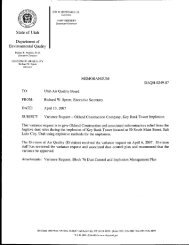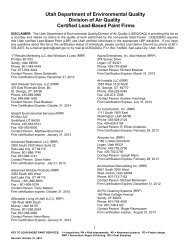Small Source Exemption Registration Instructions - Division of Air ...
Small Source Exemption Registration Instructions - Division of Air ...
Small Source Exemption Registration Instructions - Division of Air ...
Create successful ePaper yourself
Turn your PDF publications into a flip-book with our unique Google optimized e-Paper software.
Utah <strong>Division</strong> <strong>of</strong> <strong>Air</strong> Quality Revised: 6/21/06Attachment A: <strong>Small</strong> <strong>Source</strong> <strong>Exemption</strong> <strong>Registration</strong> <strong>Instructions</strong>General <strong>Instructions</strong>:Estimate your emissions using the appropriate emission worksheet, see Attachment D, E, and F. Theseworksheets layout calculations for equipment that a business would typically use for each category. If any<strong>of</strong> the worksheets have equipment not used by the business then write in: not applicable. When estimatingemissions from painting processes the calculation is a two step process: the first estimates the volatileorganic compounds (VOCs) and the second determines the hazardous air pollutants in the VOCs.Remember the calculated emissions must be less than 5 tons per year per air contaminant <strong>of</strong> any <strong>of</strong> thefollowing air contaminants: sulfur dioxide (SO 2 ), carbon monoxide (CO), nitrogen oxides (NO x ), particulatematter (PM 10 ), ozone (O 3 ), or volatile organic compounds (VOCs). Hazardous air pollutant emissions mustbe less than 500 pounds per year <strong>of</strong> any one hazardous air pollutant and less than 2000 pounds peryear <strong>of</strong> any combination <strong>of</strong> hazardous air pollutants. And actual emissions are less than 500 poundsper year <strong>of</strong> any air contaminant not listed above and less than 2000 pounds per year <strong>of</strong> any combination <strong>of</strong>air contaminants not listed in above.Businesses are not required to submit a <strong>Registration</strong> Notice. There is a minimum fee to process theregistration notice. Send it to Permits, <strong>Division</strong> <strong>of</strong> <strong>Air</strong> Quality, POB 144820, Salt Lake City, UT84114.Lines 1 thru 5: Fill in the name, address, phone number, and fax number <strong>of</strong> the business applying forthe permit exemption. Fill in the street address if different from item 1 and directions to business ifneeded for remote locations, i.e., five miles south on highway 101, turn left at farmhouse, go 1.5miles.Line 6: Fill in the date when the business was first operational.Line 7: Describe the process that emits air pollutants to the outside air. This includes the product beingprocessed (what is it), type <strong>of</strong> process (what=s being done to it), product flow through the system (howit is being done) and the equipment used to perform the process. It might read something like this:We are spray painting whizmos in a 6 foot deep updraft booth with a fabric filter using 1 hand-heldHVLP spray gun. A batch <strong>of</strong> 4 whizmos each measuring 12 by 27 inches are put in the booth at atime. After spraying is complete, the technician allows the whizmos to dry for 3 minutes beforeremoving. A new batch is brought into the booth approximately every 11 minutes. Whizmos arecleaned with Product Green prior to painting.Line 8: List any pollution control equipment at the site. Examples <strong>of</strong> a pollution control devices arebag houses or paint booths.Line 9: Typical operating schedule would be 8am to 5pm, Monday thru Friday.Line 10: Provide an estimate <strong>of</strong> actual emissions from all emission points in pounds per year (lbs/year) <strong>of</strong>the following criteria pollutants: sulfur dioxide (SO 2 ), carbon monoxide (CO), nitrogen oxides (NO x ),particulate matter (PM 10 ), ozone (O 3 ), and volatile organic compounds (VOCs). The control efficiency<strong>of</strong> air pollution control equipment should be taken into account when estimating actual emissions. The<strong>Division</strong> <strong>of</strong> <strong>Air</strong> Quality has developed worksheets for some types <strong>of</strong> processes to help estimate youractual emissions. A list <strong>of</strong> the emission worksheets is included on page 2 <strong>of</strong> these instructions.Include information on any other air contaminants, such as hazardous air pollutants, that may be <strong>of</strong>concern. Contact the <strong>Division</strong>’s <strong>Small</strong> Business Assistance Program (SBAP) at (801) 536-4000 or(800) 270-4440 or the <strong>Division</strong>’s New <strong>Source</strong> Review section at (801) 536-4000 for more information.
Attachment A: <strong>Small</strong> <strong>Source</strong> <strong>Exemption</strong> <strong>Registration</strong> <strong>Instructions</strong> - ContinuedProvide an estimate <strong>of</strong> actual emissions from all emission points in pounds per year (lbs/yr) <strong>of</strong>hazardous air pollutants (HAPs) using the ranges provided. Actual emissions should be based on trueoperating hours taking into consideration seasonal fluctuations. Indicate which HAPs are emitted byyour business by checking the box(es) in Attachment C. A fact sheet, How to Estimate YourHazardous <strong>Air</strong> Pollutants Emissions, is available through the <strong>Division</strong>’s <strong>Small</strong> Business AssistanceProgram (SBAP) at (801) 536-4000 or (800) 270-4440.Line 11: Check the boxes and Sign the form.Definitions:Hazardous <strong>Air</strong> Pollutant (HAP): HAPs are chemicals that cause serious health and environmentaleffects. Health effects include cancer, birth defects, and nervous system problems. HAPs are released bysources, such as chemical plants, dry cleaners, printing plants, and motor vehicles (cars, trucks, buses,etc.). Refer to Attachment C for a list <strong>of</strong> the 187 HAPs and how to estimate HAP emissions.For a more comprehensive list <strong>of</strong> definitions, see R307-101-2, Utah <strong>Air</strong> Conservation Rules.List <strong>of</strong> Emission Worksheets and Other Attachments:Attachment C -- Hazardous <strong>Air</strong> Pollutant ListAttachment D -- Wood Refinisher Worksheet (Dust Collection and Paint Booth)Attachment E -- Printer Worksheet (Printing and Press Clean-up)Attachment F -- Autobody Refinisher Worksheet (Paint Booth)Fact Sheet -- How to Calculate Hazardous <strong>Air</strong> Pollutants
Note: The rule on this page describes therequirements <strong>of</strong> one permitting option. This ruleexempts you from the permitting process, notthe rules that apply to your business. There areprobably other air quality rules applicable toyour business.The air quality rules can be accessed on theinternet at :http://www.airquality.utah.gov/Planning/Rules/index.htmR307-401-9. <strong>Small</strong> <strong>Source</strong> <strong>Exemption</strong>.(1) A small stationary source is exemptedfrom the requirement to obtain an approval order inR307-401-5 through 8 if the following conditions aremet.(a) its actual emissions are less than 5 tonsper year per air contaminant <strong>of</strong> any <strong>of</strong> the followingair contaminants: sulfur dioxide, carbon monoxide,nitrogen oxides, PM 10 , ozone, or volatile organiccompounds;(b) its actual emissions are less than 500pounds per year <strong>of</strong> any hazardous air pollutant andless than 2000 pounds per year <strong>of</strong> any combination<strong>of</strong> hazardous air pollutants;(c) its actual emissions are less than 500pounds per year <strong>of</strong> any air contaminant not listed in(a)( or (b) above and less than 2000 pounds per year<strong>of</strong> any combination <strong>of</strong> air contaminants not listed in(a) or (b) above.(d) <strong>Air</strong> contaminants that are drawn from theenvironment through equipment in intake air and thenare released back to the environment withoutchemical change, as well as carbon dioxide, nitrogen,oxygen, argon, neon, helium, krypton, xenon shouldnot be included in emission calculations whendetermining applicability under (a) through (c) above.(2) The owner or operator <strong>of</strong> a source that isexempted from the requirement to obtain an approvalorder under (1) above shall no longer be exempt ifactual emissions in any subsequent year exceed theemission thresholds in (1) above. The owner oroperator shall submit a notice <strong>of</strong> intent under R307-401-5 no later than 180 days after the end <strong>of</strong> thecalendar year in which the source exceeded theemission threshold.(3) <strong>Small</strong> <strong>Source</strong> <strong>Exemption</strong> – <strong>Registration</strong>.The executive secretary will maintain a registry <strong>of</strong>sources that are claiming an exemption under R307-401-9. The owner or operator <strong>of</strong> a stationary sourcethat is claiming an exemption under R307-401-9 maysubmit a written registration notice to the executivesecretary. The notice shall include the followingminimum information:(a) identifying information, includingcompany name and address, location <strong>of</strong> source,telephone number, and name <strong>of</strong> plant site manageror point <strong>of</strong> contact;(b) a description <strong>of</strong> the nature <strong>of</strong> theprocesses involved, equipment, anticipated quantities<strong>of</strong> materials used, the type and quantity <strong>of</strong> fuelemployed and nature and quantity <strong>of</strong> the finishedproduct;(c) identification <strong>of</strong> expected emissions;(d) estimated annual emission rates;(e) any control apparatus used; and(f) typical operating schedule.(4) An exemption under R307-401-9 doesnot affect the requirements <strong>of</strong> R307-401-17,Temporary Relocation.



